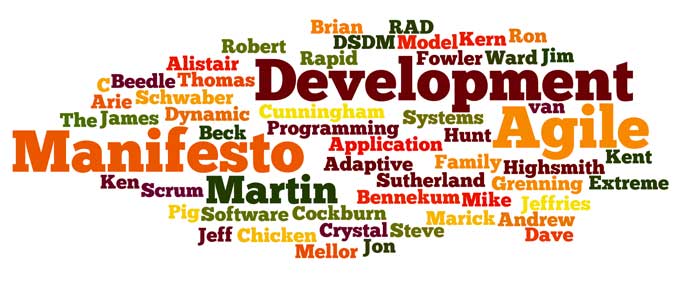
Jim Highsmith is one of the authors of the Agile Manifesto and its official historian.1 Highsmith said:
On February 11-13, 2001, at The Lodge at Snowbird ski resort in the Wasatch mountains of Utah, seventeen people met to talk, ski, relax, and try to find common ground and of course, to eat. What emerged was the Agile Software Development Manifesto. Representatives from Extreme Programming, SCRUM, DSDM, Adaptive Software Development, Crystal, Feature-Driven Development, Pragmatic Programming, and others sympathetic to the need for an alternative to documentation driven, heavyweight software development processes convened.
The 17 authors of the Agile Manifesto are:
- Kent Beck
- Mike Beedle
- Arie van Bennekum
- Alistair Cockburn
- Ward Cunningham
- Martin Fowler
- James Grenning
- Jim Highsmith
- Andrew Hunt
- Ron Jeffries
- Jon Kern
- Brian Marick
- Robert C. Martin
- Steve Mellor
- Ken Schwaber
- Jeff Sutherland
- Dave Thomas
The Agile Manifesto is a statement of principles that support agile software development. This simple, 68-word statement says:
We are uncovering better ways of developing software by doing it and helping others do it. Through this work we have come to value:
- Individuals and interactions over processes and tools
- Working software over comprehensive documentation
- Customer collaboration over contract negotiation
- Responding to change over following a plan
That is, while there is value in the items on the right, we value the items on the left more.
The twelve principles behind the Agile Manifesto are:
- Our highest priority is to satisfy the customer through early and continuous delivery of valuable software.
- Welcome changing requirements, even late in development. Agile processes harness change for the customer’s competitive advantage.
- Deliver working software frequently, from a couple of weeks to a couple of months, with a preference to the shorter timescale.
- Business people and developers must work together daily throughout the project.
- Build projects around motivated individuals. Give them the environment and support they need, and trust them to get the job done.
- The most efficient and effective method of conveying information to and within a development team is face-to-face conversation.
- Working software is the primary measure of progress.
- Agile processes promote sustainable development. The sponsors, developers, and users should be able to maintain a constant pace indefinitely.
- Continuous attention to technical excellence and good design enhances agility.
- Simplicity—the art of maximizing the amount of work not done—is essential.
- The best architectures, requirements, and designs emerge from self-organizing teams.
- At regular intervals, the team reflects on how to become more effective, then tunes and adjusts its behavior accordingly.
The framers of the Agile Manifesto emphasize the human aspect of systems development and rightfully so. All the planning in the world is not going to lead to a successful project if the people aren’t engaged. You can spiral iterations into oblivion, but if the stakeholders aren’t actively collaborating with the project team you not going to produce a product the customer needs. With the lone exception of the hybrid ICM, this is one of the weaknesses with the early Waterfall variants, the human factor falls short.


Thanks for the information provided! we will use this information into our GPT/Chat-GPT dataset